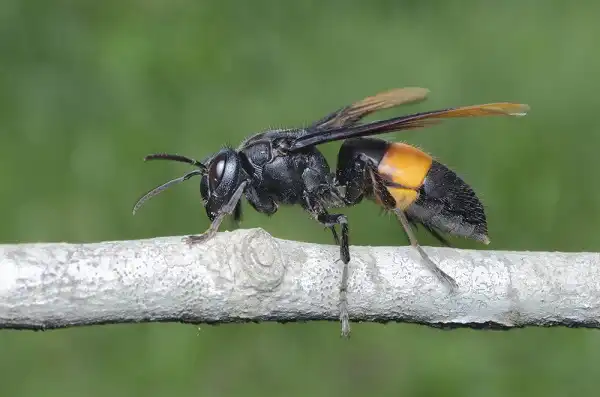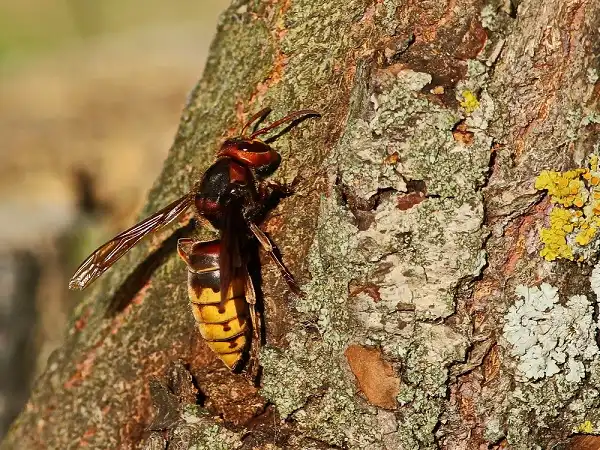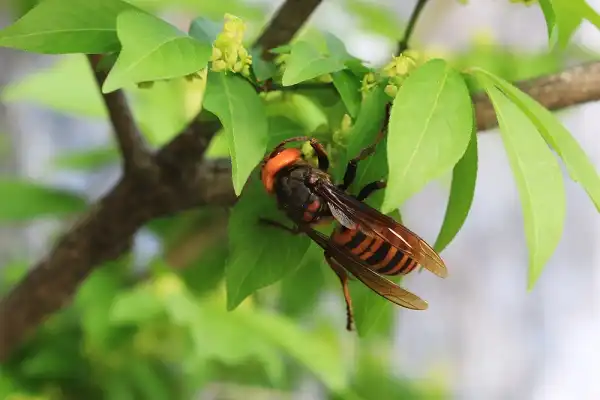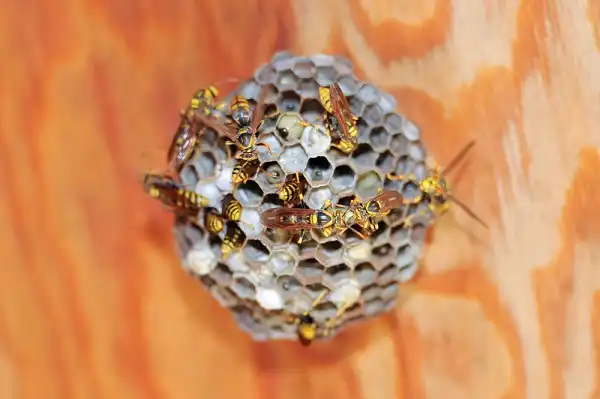With its large size and intimidating look, the Asian giant hornet is not something you want to encounter in nature. These insects’ six-millimeter stingers are potent enough to puncture conventional beekeeping suits—not to mention human skin—so it’s no surprise that an influx of these animals has sparked widespread concern recently. Despite their fearsome reputation, however, they’re actually very important members of the environment. In this blog post, we’ll take a closer look at why this misunderstood insect deserves our respect and admiration.

Asian Giant Hornet Description
The Asian giant hornet (Vespa mandarinia) is the world’s largest species of hornet. It can reach up to two inches in length, with a wingspan of three inches. These insects are reddish-brown and yellow in color, with bright orange heads. Their eyes are large and round, giving them excellent vision for detecting prey from a distance. Their legs are long and spindly, making them fast runners and powerful jumpers. Asian giant hornets are formidable predators that hunt other insects and even small animals like lizards and mice. During mating season, these hornets fiercely compete for territory by engaging in aerial combat with rival colonies. They also use their powerful stingers to ward off potential predators
Asian Giant Hornet Habitat
The Asian giant hornet can be found across Southeast Asia, including Japan, China, and Taiwan. They typically inhabit forested areas but have been known to build their nests in urban environments as well. Their nests can be found in tree hollows or underground cavities and can grow to be the size of a basketball, housing hundreds of hornets. Despite their reputation as aggressive predators, Asian giant hornets do play an important role in their ecosystems. They serve as natural pest controllers, preying on insects that can be harmful to crops, and even help pollinate certain plants. However, due to their large size and potent sting, encounters with these hornets can be dangerous for humans. It is important to give them space and avoid disturbing their nests or provoking them in any way. With proper caution and respect for their habitat, we can coexist with these fascinating creatures and appreciate the role they play in our environment.
Asian Giant Hornet Diet
Asian giant hornets are formidable predators with a diverse diet, hunting other insects, small animals such as lizards, and even honeybee colonies. These hornets are often referred to as “bee killers” due to their capacity to decimate entire hives of honeybees in a few hours. Asian giant hornets are skilled attackers, having strong jaws to chew through the bees’ bodies and mandibles to remove their heads. The hornets use their large size to their advantage, easily overpowering individual bees and taking them down one by one. They are also known for their voracious appetite, with a single hornet capable of consuming hundreds of bees in a day. Apart from honeybees, Asian giant hornets prey on a variety of insects that can be harmful to crops, including mantises, praying mantises, butterflies, and smaller hornets. They also feed on the sap of trees and have been observed drinking nectar from flowers, making them important pollinators in their ecosystems.

Asian Giant Hornet Size
The Asian giant hornet is an impressive insect with a notably large size. Female hornets can reach up to 2 inches (5 centimeters) in length, while males are slightly smaller, at around 1.6 inches (4 centimeters). Their wingspan can reach up to 3 inches (7.6 centimeters), making them one of the largest species of hornets in the world. One of the most striking features of the Asian giant hornet is its unique coloring. The hornets have distinct orange heads with dark, teardrop-shaped eyes that are perfectly designed for detecting prey from a distance. Their thoraxes and abdomens are striped in alternating tones of yellow and black.
Asian Giant Hornet Lifespan
The Asian giant hornet, like many insect species, has a relatively short lifespan. Their life cycle begins in the spring when the queen emerges from hibernation to establish a new colony. She will start laying eggs, which will hatch into larvae that will ultimately develop into worker hornets. These worker hornets will then take over the tasks of gathering food, caring for the young, and defending the colony. The Asian giant hornet’s lifespan varies depending on its role within the colony. Queens can live up to 6 years, while male hornets typically live for only a few months. Workers, on the other hand, have an average lifespan of about 3 to 4 months. As the summer wears on, the colony will continue to grow, with new workers and reproductive individuals being produced. By the fall, the colony will have reached its maximum size, with up to 700 individual hornets. At this point, the reproductive individuals will mate, and the new queens will begin to hibernate for the winter, ready to start a new colony the following spring.
Asian Giant Hornet Behavior
Asian giant hornets are known for their aggressive behavior, which is a result of their predatory nature. They are highly skilled hunters, seeking out a range of prey species including bees, other hornets, and even small mammals. When hunting, Asian giant hornets work together in coordinated attacks, swarming and surrounding their prey before delivering a fatal sting. Their venom is highly potent, containing powerful enzymes that can dissolve body tissue and cause extreme pain. In addition to their predatory behavior, Asian giant hornets are also known for their defensive tactics. When threatened, they will release alarm pheromones that signal the rest of the colony to attack. These attacks can be highly coordinated and can pose a significant risk to humans who venture too close to their nests.
Asian Giant Hornet Speed
The Asian giant hornet is not only known for its aggressive behavior and efficient hunting techniques but also for its impressive speed. They are capable of flying at speeds of up to 25 miles per hour (40 km/h), which is an impressive feat for such a large insect. Their impressive speed allows them to easily catch up to their prey, such as bees and other hornets, which they can chase down in mid-air. In addition to their impressive speed, Asian giant hornets are also capable of traveling long distances when foraging for food. They can fly up to 60 miles (96 km) in search of nectar, pollen, and other food sources. During their foraging trips, they also help to pollinate a variety of plants, allowing for the growth and reproduction of plant species.

Asian Giant Hornet Hunting
Asian giant hornets are one of the most ferocious predators in the insect world. Their hunting skills and tactics are highly evolved and incredibly effective, allowing these formidable creatures to prey on a wide range of animals, including bees, other hornets, and even small mammals. When hunting, Asian giant hornets typically work together in coordinated attacks, utilizing their superior speed and agility to gain the advantage over their prey. They can fly at incredible speeds of up to 25 miles per hour, allowing them to catch up to their targets in a flash. Their powerful mandibles and sharp stinger allow them to make quick work of their prey, delivering a fatal sting that can dissolve body tissues and cause excruciating pain. One of the most intriguing aspects of Asian giant hornet hunting behavior is their ability to track and take down flying prey. Their advanced visual system and superior sensory capabilities allow them to detect the precise location of their prey and execute a coordinated attack. They often fly directly at their target, latching onto them with their powerful mandibles and delivering a quick and deadly sting.
Asian Giant Hornet Relationship with Humans
The Asian giant hornet is capable of inflicting painful stings, and it will attack if provoked or disturbed. While they are not typically aggressive towards humans, it is important to be aware of their presence and take caution around their nests. When hiking in areas with hornets, it is best to wear protective clothing such as long pants and sleeves, as well as a hat or hoodie. It’s also recommended to avoid loud noises and sudden movements that could provoke an attack. If one comes across a nest, it’s best to leave the area immediately without attempting to disturb the nest in any way. By respecting these creatures’ habitats and being mindful of our actions, we can peacefully coexist with them and appreciate their impressive hunting skills from a safe distance. With careful awareness and caution, we can enjoy the benefits of these incredible creatures without compromising our safety or theirs.
Asian Giant Hornet Life Cycle
Asian giant hornets complete a complex life cycle that is composed of four stages: egg, larva, pupa, and adult. The adult female lays eggs in underground nests during the late spring and early summer months. After hatching, the eggs develop into the larval stage, which feeds on secretions from workers and stored food sources such as other insects or honey. Next comes the pupal stage where the larvae will form a cocoon-like structure to protect themselves during their transformation into an adult. Finally, after several weeks of metamorphosis, the adults emerge ready to hunt for food and reproduce. In some cases, these adults may also be involved in defending their nest against potential invaders. With proper knowledge about their behavior and lifecycle, we can understand how these creatures interact with their environment and appreciate their importance in maintaining a balanced ecosystem.

Conclusion
The Asian giant hornet is one of the most incredible and formidable predators in the insect world. Their impressive speed and hunting skills have earned them a fearsome reputation, while their pollination habits are essential for the health and survival of many plant species. Despite their ability to inflict painful stings, they are not inherently aggressive and will only attack when provoked. It is important that we take steps to protect these fascinating creatures, respecting their habitats and coexisting peacefully with them in our environment. With careful awareness and caution, we can enjoy the benefits of these incredible creatures without compromising our safety or theirs.
Frequently Asked Question


